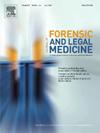Fulminant pulmonary fat embolism – undetected silent killer
IF 1.2
4区 医学
Q3 MEDICINE, LEGAL
引用次数: 0
Abstract
Background
Fulminant pulmonary fat embolism (PFE) is the most severe form of fat embolism. The aim of the study was to assess the presence/severity of PFE in individuals following major blunt trauma with no plausible cause of death identified at autopsy.
Methods
This was a prospective cohort study conducted at the University Hospital Ostrava, Czech Republic. During the study period, all persons who died after major trauma and were brought to the Department of Forensic Medicine were assessed for the study eligibility.
Results
A total of 134 deaths were due to major blunt trauma (road traffic accident victims, crime victims, suicide victims). Of these, the autopsy didn't reveal an obvious gross traumatic cause of death in 19 people who were included in the study. The mechanisms of trauma included falls (6 cases) and road traffic accidents (13 cases).
Severe injuries were found in 57.8 % of cases and multiple severe injuries in 36.8 % of cases. However, none of these serious injuries were considered fatal/lethal. Heart failure and brain swelling were the most common causes of death in the study group; fulminant PFE was the main cause of death in 4 (21.1 %) of cases.
Microscopic examination of lung cryosections revealed PFE grade I – III in all study cases. That's why the pathologists pronounced PFE as an important factor contributing to the onset of death in all study cases. In addition, massive PFE (grade III) was identified as the main cause of death in 21.1 % of cases.
Conclusions
PFE is a common injury in persons following major blunt trauma, occurring acutely within the first few minutes after the insult. In individuals in whom no other plausible cause of death is found at autopsy, the forensic pathologist must consider PFE as a potential cause of death or as an important factor contributing to the onset of death.
暴发性肺脂肪栓塞——未被发现的无声杀手
暴发性肺脂肪栓塞(PFE)是最严重的脂肪栓塞形式。该研究的目的是评估严重钝性创伤后未在尸检中确定合理死因的个体PFE的存在/严重程度。方法:这是一项在捷克共和国奥斯特拉发大学医院进行的前瞻性队列研究。在研究期间,所有在重大创伤后死亡并被带到法医部门的人都被评估为研究资格。结果严重钝性创伤死亡134例(道路交通事故死亡、犯罪死亡、自杀死亡)。其中,19名研究对象的尸检没有显示出明显的严重创伤性死亡原因。创伤机制包括跌倒(6例)和道路交通事故(13例)。重度损伤占57.8%,多发损伤占36.8%。然而,这些严重的伤害都不被认为是致命的。心力衰竭和脑肿胀是研究组中最常见的死亡原因;暴发性PFE是4例(21.1%)病例的主要死亡原因。肺冷冻切片显微镜检查显示所有病例PFE均为I - III级。这就是为什么病理学家认为PFE是所有研究病例中导致死亡的一个重要因素。此外,21.1%的病例中,大量PFE (III级)被确定为主要死亡原因。结论spfe是钝性外伤后常见的损伤,多发于伤后几分钟内。对于在尸检中没有发现其他合理死因的个人,法医病理学家必须将PFE视为潜在的死亡原因或导致死亡的一个重要因素。
本文章由计算机程序翻译,如有差异,请以英文原文为准。
求助全文
约1分钟内获得全文
求助全文
来源期刊

Journal of forensic and legal medicine
MEDICINE, LEGAL-
CiteScore
2.70
自引率
6.70%
发文量
106
审稿时长
57 days
期刊介绍:
The Journal of Forensic and Legal Medicine publishes topical articles on aspects of forensic and legal medicine. Specifically the Journal supports research that explores the medical principles of care and forensic assessment of individuals, whether adult or child, in contact with the judicial system. It is a fully peer-review hybrid journal with a broad international perspective.
The Journal accepts submissions of original research, review articles, and pertinent case studies, editorials, and commentaries in relevant areas of Forensic and Legal Medicine, Context of Practice, and Education and Training.
The Journal adheres to strict publication ethical guidelines, and actively supports a culture of inclusive and representative publication.
 求助内容:
求助内容: 应助结果提醒方式:
应助结果提醒方式:


